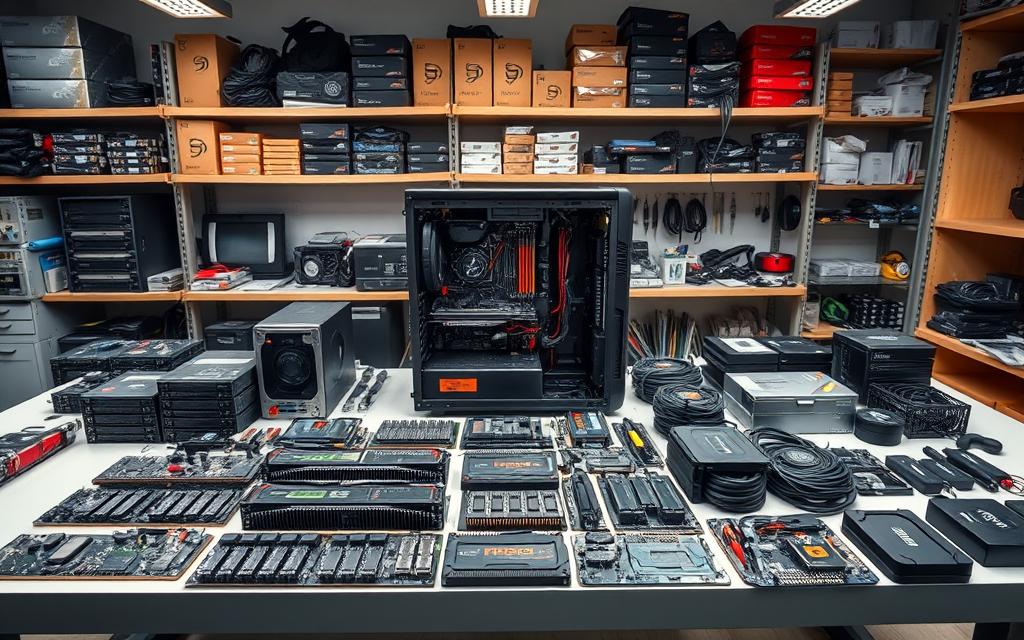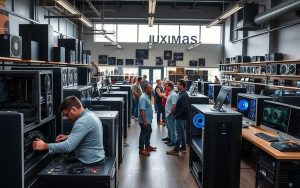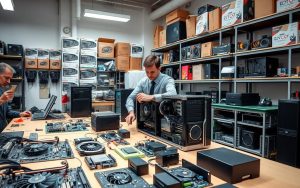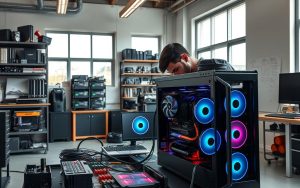Table of Contents
The tech-driven market of 2025 offers exciting opportunities for those looking to enter the PC building industry. With advancements in technology and increasing demand for customized pcs, this sector is ripe for innovation. However, success requires a blend of technical expertise and sharp business acumen.
Major players like Dell and HP dominate the landscape, making it essential for small businesses to carve out a niche. Strategic partnerships and specialized services can help differentiate your offerings. From sourcing high-quality components to optimizing workspace efficiency, every detail matters.
Building a customer-centric model is crucial. Providing reliable support and tailored solutions will set your business apart. As the industry evolves, staying ahead of trends and adapting to consumer needs will be key to long-term success.
Introduction to the PC Building Business
The world of custom computing blends creativity with technical expertise. This business thrives on delivering tailored solutions that meet specific needs. As Todd Klein from Total Data Solutions notes, “Custom PC work requires large volume for profitability (150+ units/month).” This highlights the importance of scaling operations effectively.
One major trend is the shift from hardware sales to service-based revenue models. Companies like Vision Computers have successfully implemented this strategy. They offer high-end gaming rigs priced at $3,000 and service contracts worth $1,800 per month. This approach ensures steady income while meeting customer demands.
However, modern challenges persist. Component obsolescence, vendor relationships, and inventory management are critical areas to address. Staying updated with the latest tech advancements is essential to remain competitive.
To succeed, you’ll need the right tools. Anti-static workspaces, diagnostic equipment, and specialized software are non-negotiable. These ensure precision and efficiency in every system you build.
Hybrid business models are gaining traction. Combining custom builds with IT services offers a comprehensive way to serve clients. This approach not only diversifies revenue streams but also strengthens customer loyalty.
Understanding the Market in 2025
The PC industry in 2025 is evolving rapidly, driven by innovation and consumer demand. Custom computing is shifting from hardware sales to service-based models, with 40% of revenue now coming from maintenance and consulting. This trend highlights the importance of adapting to new market dynamics.

Emerging sectors like AI workstations, cloud gaming rigs, and hybrid office solutions are gaining traction. These areas offer significant growth potential for businesses that can deliver tailored systems. Companies like Vision Computers have successfully transitioned to high-margin security infrastructure services, showcasing the value of diversification.
Market Trends and Opportunities
Edge computing and modular PC architectures are reshaping the industry. These innovations allow for more flexible and efficient systems, meeting the needs of a diverse customer base. For example, AM5/Ryzen 7000 and Intel 13th Gen CPUs are dominating professional builds, reflecting the demand for cutting-edge technology.
Component lifecycle trends also play a crucial role. DDR5 adoption rates and PCIe 5.0 storage solutions are setting new standards for performance. Staying updated with these advancements ensures your business remains competitive in a fast-paced market.
Competitor Analysis
Major players like Dell and HP continue to dominate, but their strategies differ. Dell focuses on enterprise solutions, while HP emphasizes consumer dominance. Understanding these approaches can help you identify gaps and opportunities in the case of your business.
For instance, Vision Computers’ shift to security infrastructure services demonstrates the potential of high-margin offerings. By analyzing competitors’ strengths and weaknesses, you can refine your strategy and carve out a unique niche in the industry.
How to Start a PC Building Business
Launching a custom computing venture requires careful planning and execution. Startup costs typically range from $15,000 to $50,000, depending on the scale of your business. This investment covers essential tools, workspace setup, and initial inventory.
You’ll need to follow a step-by-step roadmap to ensure a smooth launch. Begin with obtaining necessary certifications, such as FCC and UL safety standards. Next, set up an ESD-safe workspace equipped with thermal testing tools and BIOS programming software. These tools are critical for precision and efficiency.
Vendor onboarding is another crucial step. Establish relationships with reliable suppliers for components like hard drives and CPUs. Effective inventory management is key—consider Just-In-Time sourcing to minimize storage costs and avoid overstocking.
Compliance is non-negotiable. Ensure your business meets local licensing requirements and industry standards. This not only builds credibility but also protects your operations from legal issues.
Staffing is equally important. Balance your team with technical experts and customer service professionals. This ensures smooth operations and excellent client support, setting your custom pcs apart in a competitive market.
| Inventory Strategy | Benefits |
|---|---|
| Just-In-Time Sourcing | Reduces storage costs and minimizes obsolete inventory |
| Bulk Purchasing | Lowers per-unit costs for high-demand components |
| Supplier Partnerships | Ensures timely delivery and competitive pricing |
By following this process, you’ll establish a solid foundation for your venture. Focus on quality, efficiency, and customer satisfaction to thrive in the custom computing industry.
Choosing Your Niche
Selecting the right niche is critical for success in the custom computing industry. Focusing on a specific audience allows you to tailor your offerings and maximize profitability. Two prominent areas stand out: gaming PCs and professional workstations.

Gaming PCs: A Lucrative Niche
High-end gaming PCs command 35%+ margins, making them a profitable choice. Gamers demand top-tier performance, often seeking RGB customization and liquid cooling solutions. These features enhance both aesthetics and functionality.
Partnering with platforms like Twitch can boost visibility. Trade show demonstrations also attract enthusiasts. This way, you can build a loyal customer base while showcasing your expertise.
Custom Builds for Professionals
Professional systems require specialized components like ECC memory, Quadro GPUs, and Xeon processors. These ensure reliable processing for demanding tasks. Industries like medicine and law often need HIPAA-compliant storage and multi-monitor setups.
For example, content creators often invest in $5k+ rigs with Threadripper PRO CPUs. These builds handle heavy workloads efficiently, making them ideal for video editing and 3D rendering.
| Niche | Key Features |
|---|---|
| Gaming PCs | RGB customization, liquid cooling, high FPS performance |
| Professional Workstations | ECC memory, Quadro GPUs, multi-monitor setups |
By focusing on these niches, you can deliver tailored solutions that meet specific needs. This approach ensures customer satisfaction and long-term success in the custom computing industry.
Building Strategic Partnerships
Strategic partnerships are essential for growth in the custom computing industry. Collaborating with the right company can streamline operations and enhance your product offerings. These alliances provide access to resources and expertise that can elevate your business.

Collaborating with Software Providers
Partnering with software providers like Microsoft and Red Hat can reduce costs and improve efficiency. Negotiating OEM agreements ensures access to essential operating systems. This collaboration also strengthens your services and builds credibility with clients.
Co-branding initiatives with peripheral manufacturers can further enhance your offerings. These partnerships create a seamless experience for customers. They also provide additional support and resources for your business.
Working with Distributors
Leveraging distributor networks like Ingram Micro offers bulk pricing on components. This approach reduces costs and ensures timely delivery of parts. Utilizing distributor RMA systems simplifies warranty management and improves customer satisfaction.
Building referral networks with local IT service providers can expand your reach. These partnerships create opportunities for cross-promotion and shared credit. They also enhance your ability to meet diverse client needs.
NextDayPC’s virtual fulfillment handles 85% of build logistics for partners. This model demonstrates the value of strategic alliances in scaling operations. By focusing on these partnerships, you can achieve long-term success in the custom computing industry.
Sourcing Quality Components
Success in the custom computing industry hinges on sourcing the right components. High-quality parts ensure reliability and performance, which are critical for customer satisfaction. With component prices dropping 2-5% monthly, timing your purchases can significantly impact profitability.

Choosing the Right Distributors
Vetting distributors is a crucial step in the sourcing process. Companies like Newegg Business and Tech Data offer reliable partnership models. These distributors provide access to a wide range of hard drives, CPUs, and other essential components.
Implementing Just-In-Time (JIT) inventory with automated reorder systems can streamline operations. This approach minimizes storage costs and ensures you always have the necessary parts on hand. Corsair’s distributor portal is an excellent example of how authorized resellers can benefit from efficient supply chains.
Avoiding Overstocking
Overstocking can lead to financial strain, especially with rapidly evolving technology. Component authentication is essential to avoid counterfeit GPUs and refurbished SSDs. Spotting these issues early saves time and resources.
Salvage operations, such as repurposing enterprise decommissioned hardware, offer a cost-effective way to source components. This method not only reduces waste but also provides access to high-quality parts at a lower cost.
- Vet distributors carefully to ensure reliability.
- Use JIT inventory to minimize storage costs.
- Authenticate components to avoid counterfeits.
- Explore salvage operations for cost-effective sourcing.
By focusing on these strategies, you can ensure a steady supply of quality components while maintaining profitability.
Setting Up Your Workspace
A well-organized workspace is the backbone of any successful custom computing operation. Ensuring a clean and efficient environment is critical for delivering high-quality systems. Proper setup minimizes errors and maximizes productivity.
Importance of a Clean Environment
Static control is essential in a workspace. According to ASCRI standards, maintaining humidity levels below 40% prevents static buildup. This protects sensitive components from damage.
An ESD-safe workstation setup includes grounded mats and ionizing fans. These tools reduce static discharge, ensuring the safety of your system components. Air filtration systems are also crucial for solder fume extraction, maintaining a healthy workspace.
Essential Tools and Equipment
You’ll need diagnostic tools and burn-in test racks, which typically cost $3k+. These ensure each case meets performance standards. Optimizing your workspace layout for assembly line efficiency is another key step.
Compliance with local fire codes is non-negotiable, especially for lithium battery storage. This ensures safety and avoids legal issues. Proper cooling solutions, like fans or liquid cooling systems, are also vital for maintaining optimal performance.
- Use grounded mats and ionizing fans for static control.
- Invest in air filtration systems for a clean workspace.
- Equip your workspace with diagnostic tools and burn-in test racks.
- Optimize layout for assembly line efficiency.
- Ensure compliance with fire codes for lithium battery storage.
By focusing on these elements, you’ll create a workspace that supports precision and efficiency. This way, you can deliver reliable systems that meet customer expectations.
Creating a Customer-Centric Business Model
Focusing on customer needs drives long-term success in the tech industry. A customer-first approach ensures satisfaction and builds loyalty. By offering tailored solutions and reliable support, businesses can stand out in a competitive market.
Vision Computers’ 15-minute response SLA has increased retention by 40%. This highlights the importance of quick and efficient services. Implementing tools like Splashtop Enterprise for remote diagnostics ensures customers receive timely assistance.
Offering Remote Support
Remote support is a game-changer for modern businesses. It allows technicians to troubleshoot issues without being on-site. Tools like Splashtop Enterprise enable secure remote access, reducing downtime and improving customer satisfaction.
Developing tiered support packages, such as Silver, Gold, and Platinum, caters to diverse client needs. These packages offer varying levels of assistance, ensuring every customer receives the right level of care.
Quick Response Times
Speed is critical in the tech industry. AI-driven ticket routing systems streamline the time it takes to address customer inquiries. This ensures issues are resolved promptly, enhancing the overall experience.
Training staff using the CompTIA Customer Service Specialist curriculum equips them with the skills to handle complex system issues. On-site service fleets, complete with branded vehicles and toolkits, further enhance response capabilities.
- Implement remote diagnostics for efficient troubleshooting.
- Offer tiered support packages to meet diverse needs.
- Train staff with specialized customer service skills.
- Use AI-driven systems to streamline ticket routing.
- Maintain on-site fleets for quick physical support.
By prioritizing customer needs and leveraging advanced tech, businesses can create a model that fosters loyalty and growth. For more insights, explore this guide on building a customer-centric approach.
Legal and Financial Considerations
Navigating the legal and financial landscape is essential for any tech venture. Proper planning ensures compliance and long-term success. From registering your business to understanding vendor return policies, every step matters.
Registering Your Business
Choosing the right entity structure is a critical first step. Options like LLCs and S-Corps have different tax implications. An LLC offers flexibility, while an S-Corp can reduce self-employment taxes. Consulting a legal expert can help you make the best choice.
Sales tax nexus rules vary by state. If you operate in multiple states, understanding these regulations is crucial. Compliance ensures you avoid penalties and maintain good standing.
Understanding Vendor Return Policies
Vendor return policies, or RMAs, are a key part of the process. According to Morris Rosenthal, RMAs typically require 72-hour vendor processing. This timeframe impacts your ability to address customer issues promptly.
Cross-shipment RMA strategies with brands like ASUS and Gigabyte can streamline returns. This way, you can replace defective components without delays, ensuring customer satisfaction.
| Consideration | Key Details |
|---|---|
| Entity Selection | LLC vs. S-Corp tax implications |
| Sales Tax Nexus | Navigating multi-state operations |
| Warranty Compliance | Magnuson-Moss Act requirements |
| Supplier Terms | Implementing Net 30 terms |
| RMA Strategies | Cross-shipment with ASUS and Gigabyte |
Implementing Net 30 terms with component suppliers can improve cash flow. This approach allows you to pay for products within 30 days, giving you more flexibility. Building strong vendor relationships also enhances your creditworthiness.
Compliance with warranty laws, such as the Magnuson-Moss Act, protects your business and builds trust with customers. Ensuring transparency in your policies is key to maintaining a positive reputation.
Marketing Your PC Building Business
Effective marketing strategies are essential for standing out in the competitive tech industry. A well-rounded approach combines traditional methods with modern digital tools to maximize reach and engagement. Understanding your target audience and their preferences is key to crafting impactful campaigns.
Flyers and direct mail remain powerful tools for local outreach. According to Rosenthal research, direct mail coupons achieve an 8.5% conversion rate. This method is particularly effective for targeting specific neighborhoods or demographics. Pairing flyers with geofenced Google Ads can further amplify your local presence.
Building an online presence is equally important. A video series showcasing custom water-cooling projects on YouTube can attract tech enthusiasts. These videos not only highlight your expertise but also engage potential customers visually. Social media platforms are ideal for promoting trade-in programs with unboxing incentives, encouraging user-generated content.
SEO strategies, such as schema markup for PC configurator pages, improve search engine visibility. This ensures your services are easily discoverable by those searching for custom solutions. Community engagement, like sponsoring local eSports tournaments, fosters brand loyalty and connects you with your customer base.
By blending offline and online marketing efforts, you can create a comprehensive strategy that drives growth. Focus on delivering value and building relationships to establish a strong foothold in the market.
Scaling Your Business
Expanding operations in the tech industry requires strategic planning and adaptability. Successful firms often add 2-3 revenue streams within 18 months, according to the SBA. This growth involves diversifying offerings and optimizing resources to meet evolving market demands.
Adding New Services
Enterprise expansion is a key strategy for scaling. Managed IT services and B2B contracts can significantly boost revenue. These offerings cater to businesses seeking comprehensive tech solutions, ensuring steady income streams.
Implementing ERP systems like NetSuite streamlines inventory management. This enhances efficiency and reduces operational costs. Franchise model development is another avenue, allowing for broader market reach while maintaining brand consistency.
Acquisition strategies for failing computer repair shops can also drive growth. By integrating these businesses, you expand your customer base and resources. Each of these approaches requires careful planning to ensure long-term success.
Hiring and Training Staff
As your business grows, you’ll need a skilled team to support operations. Staff certification paths, from CompTIA A+ to Cisco CCNP, ensure technical expertise. These certifications build credibility and enhance service quality.
Investing in training programs improves employee retention and performance. A well-trained team can handle complex system issues efficiently. This reduces downtime and increases customer satisfaction.
Scaling your venture is a continuous process. By focusing on adding value and building efficiency, you can achieve sustainable growth in the competitive tech industry.
Conclusion
The journey into custom computing demands both skill and strategy. To thrive, focus on niche dominance and service diversification. These pillars ensure you stand out in a competitive market.
Continuous learning is essential. The tech landscape evolves rapidly, and staying updated ensures your business remains relevant. Embrace innovation and adapt to new trends.
Before launching, ensure you have $15k startup capital, solid vendor contracts, and a robust marketing plan. These elements lay the foundation for success.
Looking ahead, AI-assisted builds and quantum computing prep will shape the way we approach custom systems. Stay ahead by integrating these advancements into your offerings.
Ready to take the next step? Begin with business registration and explore SBA loans to fuel your passion. With the right tools and mindset, you’ll need to carve your path in this dynamic industry.
FAQ
What are the key market trends for custom PCs in 2025?
The demand for high-performance systems, especially gaming PCs and professional workstations, continues to grow. Emerging technologies like AI and VR are driving the need for advanced components such as powerful processors and graphics cards.
How do I choose the right niche for my PC building business?
Focus on areas with high demand, such as gaming PCs or custom builds for professionals. Analyze your skills and resources to determine which niche aligns best with your expertise and customer base.
What are the essential tools needed for assembling custom PCs?
You’ll need a clean workspace, anti-static tools, screwdrivers, and cable management supplies. Quality components like motherboards, processors, and cooling systems are also crucial for building reliable systems.
How can I source high-quality components for my builds?
Partner with reputable distributors and manufacturers like Intel, AMD, or NVIDIA. Research vendor return policies and avoid overstocking to maintain a steady inventory of reliable parts.
What legal steps are required to register my PC building business?
Register your business with local authorities, obtain necessary licenses, and ensure compliance with tax regulations. Consult a legal expert to understand vendor agreements and warranty policies.
How can I effectively market my PC building services?
Build an online presence through a professional website and social media platforms. Use flyers, direct mail, and video content to showcase your expertise and attract a loyal customer base.
What strategies can help scale my PC building business?
Expand your services by offering upgrades, repairs, or remote support. Hire and train skilled staff to handle increased demand while maintaining high-quality standards.
Why is a clean workspace important for assembling PCs?
A clean environment prevents dust and static damage to sensitive components like motherboards and hard drives. It ensures the longevity and performance of the systems you build.
How can I provide excellent customer support for my business?
Offer quick response times, remote troubleshooting, and detailed guides. Focus on building trust by addressing customer concerns promptly and professionally.
What are the benefits of collaborating with software providers?
Partnering with software providers allows you to offer bundled solutions, enhancing the value of your custom builds. It also helps attract customers looking for pre-configured systems.









